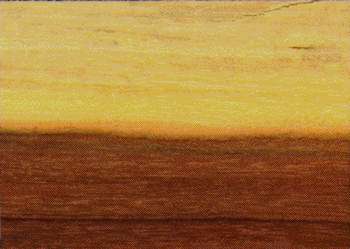
Awartu (Swartzia leiocalycina)
Family: Caesalpiniaceae
Common names: Awartu, Brown ebony, Clubwood, Ironwood, Montouchi, Shiraip, Wamara
Distributed in: French Guiana, Guyana (Latin America)
Common uses: Agricultural implements, Boat building (general), Cabinetmaking, Flooring, Flooring: industrial heavy traffic, Furniture, Handles: general, Heavy construction, Joinery, Ladders, Light construction, Mine timbers, Musical instruments, Piling, Plywood, Railroad ties, Sporting Goods, Tool handles, Turnery, Veneer, Walking sticks, Wheel spokes
Tree size: Trunk diameter is 100-150 cm
Colors: the heart isRed, Yellowand the sapwoodWhite to yellow, Yellow.The grain isWeak figure, the textureMediumand the lusterPronounced
Natural durability: Susceptible to marine borer attack, Very durable
Kiln Schedules: UK=B US=T2C2/T2C1 Fr=2
Kiln Drying Rate: Naturally dries quickly
Drying Defects: Severe end splitting, Severe surface checking
Ease of Drying: Rapidly
Tree Identification: Bole/stem form is buttressed
Comments: General finishing qualities are rated as good
Blunting Effect: High to severe
Boring: Fairly easy to very easy
Cutting Resistance: Fairly Difficult to Very Difficult to saw
Nailing: Fairly Easy to Very Easy, Possible if prebored
Planing: Very Good to Excellent
Resistance to Impregnation: Sapwood is permeable
Resistance to Splitting: Poor
Response to hand tools: Moderate working qualities
Sanding: Good sanding finish
Veneering qualities: Suitable for slicing, There is slight to moderate drying degrade and the potential for buckles and splits
Steam bending: Moderate
Screwing: Possible if prebored
; Turning: Poor to Very Poor Results
Polishing: Good; Staining: Poor;
- Numerical data Metric
- Numerical data English
- Strength properties
- References
 |
 |
 |
 |
| Item |
Green |
Dry |
Metric |
| Specific Gravity |
|
|
|
| Density |
|
945 |
kg/m3 |
| Bending Strength |
1207 |
1748 |
kg/cm2 |
| Crushing Strength |
632 |
869 |
kg/cm2 |
| Hardness |
|
1262 |
kg |
| Impact Strength |
|
187 |
cm |
| Shearing Strength |
|
192 |
kg/cm2 |
| Stiffness |
161 |
187 |
1000 kg/cm2 |
| Tangential Shrinkage |
|
|
% |
| Radial Shrinkage |
4 |
|
% |
| Weight |
929 |
817 |
kg/m3 |
| Maximum Load |
1,33 |
1,61 |
cm-kg/cm3 |
| Toughness |
|
418 |
cm-kg |
| Static Bending |
|
|
kg/cm2 |
|
 |  |  |  | | Item | Green | Dry | English | | Bending Strength | 17175 | 24865 | psi | | Density | | 59 | lbs/ft3 | | Hardness | | 2784 | lbs | | Impact Strength | | 74 | inches | | Maximum Crushing Strength | 8990 | 12374 | psi | | Shearing Strength | | 2745 | psi | | Stiffness | 2304 | 2667 | 1000 psi | | Toughness | | 363 | inch-lbs | | Work to Maximum Load | 19 | 23 | inch-lbs/in3 | | Weight | 58 | 51 | lbs/ft3 | | Radial Shrinkage | 4 | | % | | Tangential Shrinkage | 7 | | % | |
Density (dry weight) = 61-67 lbs/cu. ft.
Bending strength (MOR) = very high
Modulus of Elasticity (stiffness) = high
Max. crushing strength = very high
Density (dry weight) = >75 lbs/cu. ft.
Density (dry weight) = 67-75 lbs/cu. ft.
Density (dry weight) = 53-60 lbs/cu. ft.
Hardness (side grain) = very hard
Bending strength (MOR) = high
Shrinkage, Tangential = moderate
Shrinkage, Radial = small
Shrinkage, Radial = moderate
Shearing strength (parallel to grain) = very high
Shearing strength (parallel to grain) = medium
Shearing strength (parallel to grain) = high
Modulus of Elasticity (stiffness) = very high
Max. crushing strength = high
Toughness-Hammer drop (Impact Strength) = very high
Toughness (total work) = high
Shrinkage, Tangential = small
Shrinkage, Tangential = fairly large
Hardness (side grain) = hard
Bending strength (MOR) = medium
Berni, C.A., Bolza, E., Christensen, F.J.,1979,South American Timbers - The Characteristics, Properties and Uses of 190,Species,C.S.I.R.O Div. Building ResearchErfurth, T., Rusche, H.,1976,The Marketing of Tropical Wood B. Wood Species from S. American Tropical,Moist Forests,F.A.O. Forestry DepartmentFanshawe, D.B.,1954,Forest Products of British Guiana Part 1 Principal Timbers,Forest Department British Guiana Forestry Bulletin (New Series 2nd,Edition,No.1Forests Products Research Laboratory, U.K.,1956,A Handbook of Hardwoods,Forest Products Research Laboratory, Princes Risborough, Department of,Science and Industrial Research, Building Research EstablishmentI.U.F.R.O.,1973,Veneer Species of the World,Assembled at F.P.L. Madison on behalf of I.U.F.R.O. Working Party on,Slicing and Veneer CuttingLavers, G.M.,1983,The Strength Properties of Timber (3rd ed. revised Moore G.L.,Forest Products Research Laboratory, Princes Risborough, Building Research,Establishment Report (formerly Bulletin No.50)Longwood, F.R.,1962,Commercial Timbers of the Caribbean,U.S.A. Department of Agriculture, Agriculture Handbook,No.207Polak, A.M.,1992,Major Timber Trees of Guyana A Field Guide,The Tropenbos Foundation Wageningen, The NetherlandsSlooten, H.J. van der,1970,Evaluation Study of eighteen Wood Species from Guyana for Veneer and,Plywood Manufacture,Forest Industries Development Survey FAO Report SF/GUY9 Tech. Report,No.13,U.N.D.P.Takahashi, A.,1975,Compilation of data on the Mechanical Properties of Foreign Woods (Part 2,Central and South America,Shimane University, Japan, Research Report on Foreign Wood No.4
|








